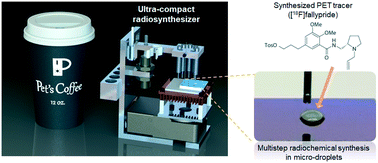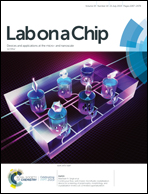Ultra-compact, automated microdroplet radiosynthesizer†
Abstract
Application of microfluidics offers numerous advantages in the field of radiochemistry and could enable dramatic reductions in the cost of producing radiotracers for positron emission tomography (PET). Droplet-based microfluidics, in particular, requires only microgram quantities of expensive precursors and reagents (compared to milligram used in conventional radiochemistry systems), and occupies a more compact footprint (potentially eliminating the need for specialized shielding facilities, i.e. hot cells). However, the reported platforms for droplet radiosynthesis have several drawbacks, including high cost/complexity of microfluidic reactors, requirement for manual intervention (e.g. for adding reagents), or difficulty in precise control of droplet processes. We describe here a platform based on a particularly simple chip, where reactions take place atop a hydrophobic substrate patterned with a circular hydrophilic liquid trap. The overall supporting hardware (heater, rotating carousel of reagent dispensers, etc.) is very simple and the whole system could be packaged into a very compact format (about the size of a coffee cup). We demonstrate the consistent synthesis of [18F]fallypride with high yield, and show that protocols optimized using a high-throughput optimization platform we have developed can be readily translated to this device with no changes or re-optimization. We are currently exploring the use of this platform for routine production of a variety of 18F-labeled tracers for preclinical imaging and for production of tracers in clinically-relevant amounts by integrating the system with an upstream radionuclide concentrator.



 Please wait while we load your content...
Please wait while we load your content...